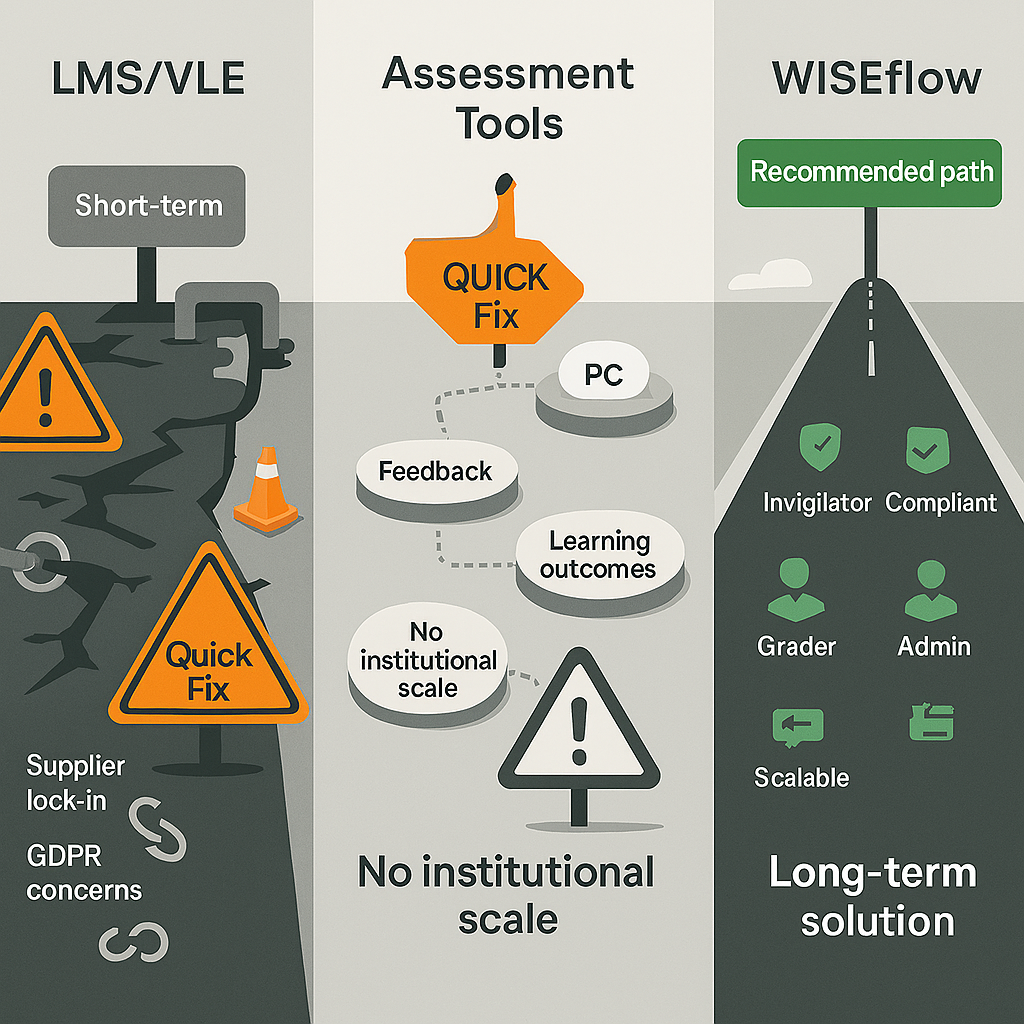LMS, tools, or a dedicated assessment platform? Choosing the right path for digital exams
When institutions wish to move their exams and assessment online, they often face a challenge of which path to take. While many opt for a dedicated exam and assessment platform like WISEflow, others unfortunately end up taking one of two routes which often prove difficult and lack a long-term perspective:
Route 1: Stretching the LMS/VLE beyond its purpose
They look at the platform they already have e.g. Moodle, Canvas, Blackboard etc. and try to bend it to handle all their exams and assessments. While these systems are excellent for teaching and learning, and offer some kind of formative assessment capabilities, they were never designed for the complexity of summative high-stakes assessment throughout the institution.
LMS/VLEs has the classroom as its core entity around which all functionality is build. However, exams and assessment at an institution like a university, don’t operate in classrooms, but in exams and assessments modules, which has a very different workflow, compliance scheme and orchestration. It also involves many other roles that are not normally part of the VLE/LMS e.g. invigilators, moderators, reviewers, external examiners etc.
However, trying to bend the LMS/VLE is rarely enough. Institutions often also need to add extra modules or bolt-on tools to cover the wide variety of exam and assessment formats used across academia, and that are not part of the basic formative capabilities of the VLE/LMS. This leads to:
A patchwork of systems that often don’t integrate seamlessly.
Increased operational complexity and maintenance overhead stacked onto the IT-department.
Unsecure supplier situations, where multiple vendors create risk for compliance and continuity, adding to this privacy, accessibility and GDPR complexity and concerns.
Poor general workflow and dedicated role support for conducting and managing exams and assessment at scale across the institution.
Limited scalability, making it hard to manage growth or adapt to new requirements.
The result? A fragile setup that lacks the robustness and efficiency needed for institutional-level assessment.
Route 2: The tool-approach or leaving it to individual teachers
Others take a more de-centralised or voluntary approach, leaving the move towards digital exams and assessment to the instructors by letting them choose personal tools on their own. They may choose appropriate tools like Grade, FeedbackFruits, SpeedGrader or similar, that work very well for isolated assessment or feedback tasks, and which support the more formative teacher-student relation.
However, this approach ignores the benefit of focusing on the bigger picture: the institution-wide workflows, efficiency gains, and consistent quality standards. While such tools may be great locally, they don’t help support institution-wide workflows, such as central exam management, and does not integrate to SIS/SRS (student information systems to secure data quality and consistency. Likewise, such a voluntary approach can be hard to leverage quality assurance broadly as well as other quality standards across the institution.
These approaches end up short-term, but are taken as institutions often:
Don’t know the real alternative like a dedicated institution-wide platform built for exams and assessments.
Fear the change management project or change resistance to a dedicated solution for all involved.
Think the step to a dedicated platform is too big or too expensive.
Convince themselves they can achieve the same quality with what they already have, even though the reality proves otherwise.
Why LMS/VLE isn’t enough
LMS platforms are designed for teaching and learning workflows like managing courses, sharing resources, and facilitating communication between teachers and students. They excel in supporting classroom activities, but when it comes to formal exams and structured assessment processes, they fall short.
Key limitations of LMS/VLE:
Built for course delivery, not secure, large-scale assessment.
Lack of role-specific workflows for invigilators, multiple graders, or administrators.
Simple compliance and security features for exams.
Limited orchestration of complex processes like blind marking, diverse exam formats, monitoring or appeals.
Often rely on add-on modules and external tools, creating a fragmented and error-prone ecosystem.
Why isolated assessment tools fall short
Assessment tools can be great for enhancing feedback and improving teacher-student interaction. However, they focus on teacher-student interchange, not the whole end-to-end assessment lifecycle and all the orchestration, data security, compliance and management that goes into it.
Limitations of standalone tools:
Designed for specific tasks (e.g., feedback or peer review), not full workflows.
No orchestration of roles like exam coordinators, external assessors, or quality assurance teams.
Hard to secure base level of quality assurance across institution or provide any insights or statistics on institutional level.
Often lack compliance and scalability for formal summative exams.
These tools often function more as add-ons, not as exam and assessment platforms.
Where WISEflow fits
WISEflow is a dedicated exam and assessment management platform. It doesn’t replace your LMS/VLE or compete with independent feedback tools. It complements and connects them by filling a critical gap.
What makes WISEflow different:
Purpose-built for exams and assessments at scale, not general teaching or independent assessment handling.
Supports specialised workflows: managing, authoring, scheduling, secure submissions, marking, moderation, and reporting.
Offers multiple dedicated assessment formats for both practical, oral, multi-answer, open-book and closed-book exams, plus combinations for flexibility.
Designed for multiple roles: administrators, invigilators, graders, external examiners.
Includes a high-end authoring environment for creating rich, structured assessments, and support multiple submission formats such as handwriting, pdf, office-formats, video, audio, coding, LaTex etc.
Inbuilt originality check as part of the marking process, to secure academic integrity.
Built on accessibility-first standards, ensuring equal opportunities for all learners, and can combine both digital and handwritten formats.
Fully GDPR and privacy compliant, safeguarding personal and sensitive data.
Integrates seamlessly with your course room in your VLE/LMS via LTI.
Connects to the institution’s digital ecosystem via API or direct integrations:
Student record systems
Resource and planning systems
Local and national archives
Authentication systems (local or national)
Business intelligence hubs
Student portals and much more
The fundamental difference
Think of it this way:
LMS/VLE = Classroom teaching hub.
Assessment tools = Ad hoc assessment tool or feedback enhancers.
WISEflow = Complete assessment workflow engine for all involved in the process.
By incorporating WISEflow as the dedicated platform for digital exams and assessments, institutions can:
Streamline processes and make them consistent.
Install standards and heighten institutional quality.
Reduce risk and elevate secure, privacy and GDPR compliance.
Deliver an integrated and better experience for all stakeholders, including enhancing student satisfaction.
Achieve efficiency gains, cost reductions and institutional assessment intelligence to secure forward decision making.
This matters because…
Exams and assessments are not just about providing a grade. It’s about orchestrating a secure, fair, and efficient process involving multiple roles and compliance requirements. WISEflow is built for this reality.
Ready to transform your assessment workflows?
Discover how WISEflow can help your institution move beyond LMS limitations and fragmented tools.

